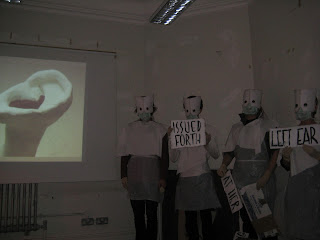I have selected the following 10 images to show some of my interests:
Laurie Knight takes some of the most amazing Macro photography of insects, this Greenbottle fly is amoungst my favourites because it just looks so alien up close! I ahve always found insects fascinating to look at, and on this scale i think it is clear why.
This image shows the Skeksis Puppets used in the film: The Dark Crystal (1982).
I remember seeing this film as a child, and since then I have loved it, not only for the creature designs but for the imaginative story, which seems so hard to find these days in any original films...
I still favour Animatronics and Puppets over CGI in films, I think they always appear more life-like and usually have a sense of horror and tangible emotions which most CGI caharacter's never have.
H.R.Giger - Metamorphosis.
Zdzislaw Beksinski
William Blake - Elohim creating Adam
Maurice Sendak - Where the Wild Things Are
Giant Asian Hornet Queen.
"Bees and the Giant Hornet Queen (BBC2). Photograph: Verity White/BBC
Buddha, Bees and the Giant Hornet Queen (Natural World, BBC2) had all the characteristics of your very least favourite nightmare. The giant hornet queen is two pointed, vicious inches long and contains enough venom to kill a man. She is a hornet with a single thought - to propagate the species. She builds a nest and pumps out multitudinous offspring: hundreds of writhing grubs in their cells, faceless, gently pulsing gobbets of shiny, pallid flesh. These develop into warrior-daughters, who slaughter a 30,000-strong honeybee colony on her behalf and bring her the corpses, enabling the next round of larval malevolence to pupate and the whole homicidal cycle to begin again. " - Lucy Mangan
Shaun Tan- two illustrations from "The Arrival"
The Natural History Museum - London
Not so much an amazing image, as an amazing building. There are stone creatures climbing and perching on every available surface of the museum, inside and out, even up to the tops of the towers.
John Howe - Eowin and the Nazgul














































